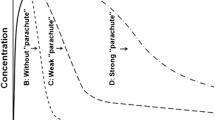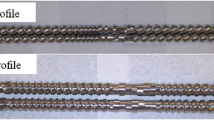Abstract
Molecular dispersions are a highly effective method of increasing bioavailability for a poorly soluble active pharmaceutical ingredient (API) and can be prepared on a large scale by hot melt extrusion (HME). Processing thermally labile active pharmaceutical ingredients (APIs) via HME is generally more difficult, with operating temperatures limited to below that of the API melting point. API melting is considered essential to facilitate the formation of a fully homogeneous amorphous system. Processing below the melting point renders the system much more susceptible to residual crystalline content; hence, HME is not suitable for APIs which degrade upon melting. In the following work, meloxicam (MEL) was used as a model API, possessing properties of high melting temperature and thermal lability. In this proof of concept work, a modified HME method, termed solvent-assisted HME, was used to overcome this issue and prepare an amorphous solid dispersion using HME, wherein a solvent was incorporated in the formulation blend during extrusion and removed post-processing. Formulations containing 10%wt meloxicam (MEL) and 90%wt polyvinylpyrrolidone vinyl acetate (PVPVA) copolymer were extruded using a twin-screw extruder at temperatures below the melting point of MEL. Dimethylformamide (DMF) solvent was added directly into the extruder barrel through a liquid addition port, resulting in extrudate products having a higher conversion of API to the amorphous form. The incorporation of solvent allowed a significant reduction in processing temperatures due to its increased mobility, while also driving the conversion of the API to its amorphous form. The solvent was successfully reduced through a secondary drying step using a vacuum oven. This advancement has demonstrated the potential for thermally labile APIs to be processed via HME expanding the applications of this technology.
Graphical Abstract








Similar content being viewed by others
References
Zografi G, Newman A. Introduction to amorphous solid dispersions. In: Newman A, editor. Pharmaceutical amorphous solid dispersions. New Jersey: Wiley; 2015. p. 1–42.
Xie T, Gao W, Taylor LS. Impact of Eudragit EPO and hydroxypropyl methylcellulose on drug release rate, supersaturation, precipitation outcome and redissolution rate of indomethacin amorphous solid dispersions. Int J Pharm. 2017;531(1):313–23. https://doi.org/10.1016/j.ijpharm.2017.08.099.
Matsumoto T, Zografi G. Physical properties of solid molecular dispersions of indomethacin with poly(vinylpyrrolidone) and poly(vinylpyrrolidone-co-vinyl-acetate) in relation to indomethacin crystallization. Pharm Res. 1999;16(11):1722–8. https://doi.org/10.1023/A:1018906132279.
Kaushal AM, Gupta P, Bansal AK. Amorphous drug delivery systems: molecular aspects, design, and performance. Crit Rev Ther Drug Carrier Syst. 2004;21(3):133–93. https://doi.org/10.1615/CritRevTherDrugCarrierSyst.v21.i3.10.
Newman A, Nagapudi K, Wenslow R. Amorphous solid dispersions: a robust platform to address bioavailability challenges. Ther Deliv. 2015;6(2):247–61. https://doi.org/10.4155/tde.14.101.
Coates PD, Barnes SE, Sibley MG, Brown EC, Edwards HGM, Scowen IJ. In-process vibrational spectroscopy and ultrasound measurements in polymer melt extrusion. Polymer (Guildf). 2003;44(19):5937–49. https://doi.org/10.1016/S0032-3861(03)00544-5.
Maniruzzaman M, Nokhodchi A. Continuous manufacturing via hot-melt extrusion and scale up: regulatory matters. Drug Discov Today. 2017;22(2):340–51. https://doi.org/10.1016/j.drudis.2016.11.007.
Nežić I, Sander A, Meštrović E, Čavužić D. Production of stable amorphous form by means of spray drying. Part Sci Technol. 2019;37(5):628–38. https://doi.org/10.1080/02726351.2017.1417936.
Kelleher JF, Gilvary GC, Madi AM, Jones DS, Li S, Tian Y, et al. A comparative study between hot-melt extrusion and spray-drying for the manufacture of anti-hypertension compatible monolithic fixed-dose combination products. Int J Pharm. 2018;545(1–2):183–96. https://doi.org/10.1016/j.ijpharm.2018.05.008.
O’Neill MJ. Meloxicam. In: Co. M and, editor. The Merck Index - an Encyclopedia of chemicals, drugs, and biologicals. New Jersey: Whitehouse Station; 2006. p. 1006.
Cheney ML, Weyna DR, Shan N, Hanna M, Wojtas L, Zaworotko MJ. Coformer selection in pharmaceutical cocrystal development: a case study of a meloxicam aspirin cocrystal that exhibits enhanced solubility and pharmacokinetics. J Pharm Sci. 2011;100(6):2172–81. https://doi.org/10.1002/jps.22434.
Cheney ML, Weyna DR, Shan N, Hanna M, Wojtas L, Zaworotko MJ. Supramolecular architectures of meloxicam carboxylic acid cocrystals, a crystal engineering case study. Cryst Growth Des. 2010;10(10):4401–13. https://doi.org/10.1021/cg100514g.
Weyna DR, Cheney ML, Shan N, Hanna M, Zaworotko MJ, Sava V, et al. Improving solubility and pharmacokinetics of meloxicam via multiple-component crystal formation. Mol Pharm. 2012;9(7):2094–102. https://doi.org/10.1021/mp300169c.
Suzuki H, Yakushiji K, Matsunaga S, Yamauchi Y, Seto Y, Sato H, et al. Amorphous solid dispersion of meloxicam enhanced oral absorption in rats with impaired gastric motility. J Pharm Sci. 2017;107(1):446–52. https://doi.org/10.1016/j.xphs.2017.05.023.
Haser A, Cao T, Lubach JW, Zhang F. In situ salt formation during melt extrusion for improved chemical stability and dissolution performance of a meloxicam-copovidone amorphous solid dispersion. Mol Pharm. 2018;15(3):1226–37. https://doi.org/10.1021/acs.molpharmaceut.7b01057.
Bhende S, Jadhav N. Moringa coagulant as a stabilizer for amorphous solids: part I. AAPS PharmSciTech. 2012;13(2):400–10. https://doi.org/10.1208/s12249-012-9755-x.
Huang S. Application of hot-melt extrusion in the manufacturing of amorphous solid dispersions containing thermally labile drugs. University of Texas at Austin; 2017. https://repositories.lib.utexas.edu/handle/2152/47149. Accessed 24 Aug 2021
HengsawasSurasarang S, Keen JM, Huang S, Zhang F, McGinity JW, Williams RO. Hot melt extrusion versus spray drying: hot melt extrusion degrades albendazole. Drug Dev Ind Pharm. 2017;43(5):797–811. https://doi.org/10.1080/03639045.2016.1220577.
Seedher N, Bhatia S. Solubility enhancement of cox-2 inhibitors using various solvent systems. AAPS PharmSciTech. 2003;4(3):36–44. https://doi.org/10.1208/pt040333.
Haser A, Huang S, Listro T, White D, Zhang F. An approach for chemical stability during melt extrusion of a drug substance with a high melting point. Int J Pharm. 2017;524(1–2):55–64. https://doi.org/10.1016/j.ijpharm.2017.03.070.
Marsac PJ, Shamblin SL, Taylor LS. Theoretical and practical approaches for prediction of drug-polymer miscibility and solubility. Pharm Res. 2006;23(10):2417–26. https://doi.org/10.1007/s11095-006-9063-9.
Moseson DE, Taylor LS. The application of temperature-composition phase diagrams for hot melt extrusion processing of amorphous solid dispersions to prevent residual crystallinity. Int J Pharm. 2018;553(1–2):454–66. https://doi.org/10.1016/j.ijpharm.2018.10.055.
Stutzman J, Huang S, Williams RO, O’Brien J, O’Donnell KP, Delpon de Vaux SM. Processing thermally labile drugs by hot-melt extrusion: the lesson with gliclazide. Eur J Pharm Biopharm. 2017;119:56–67. https://doi.org/10.1016/j.ejpb.2017.05.014.
Castro GT, Filippa MA, Sancho MI, Gasull EI, Almandoz MC. Solvent effect on the solubility and absorption spectra of meloxicam: experimental and theoretical calculations. Phys Chem Liq. 2020;58(3):337–48. https://doi.org/10.1080/00319104.2019.1594224.
Repka MA, McGinity JW. Influence of vitamin E TPGS on the properties of hydrophilic films produced by hot-melt extrusion. Int J Pharm. 2000;202(1–2):63–70. https://doi.org/10.1016/S0378-5173(00)00418-X.
Ghebremeskel AN, Vemavarapu C, Lodaya M. Use of surfactants as plasticizers in preparing solid dispersions of poorly soluble API: selection of polymer-surfactant combinations using solubility parameters and testing the processability. Int J Pharm. 2007;328(2):119–29. https://doi.org/10.1016/j.ijpharm.2006.08.010.
Crowley MM, Zhang F, Repka MA, Thumma S, Upadhye SB, Battu SK, et al. Pharmaceutical applications of hot-melt extrusion: part I review article. Drug Dev Ind Pharm. 2007;22:909–26. https://doi.org/10.1080/03639040701498759.
Agrawal AM, Dudhedia MS, Zimny E. Hot melt extrusion: development of an amorphous solid dispersion for an insoluble drug from mini-scale to clinical scale. AAPS PharmSciTech. 2016;17(1):133–47. https://doi.org/10.1208/s12249-015-0425-7.
Ma X, Huang S, Lowinger MB, Liu X, Lu X, Su Y, et al. Influence of mechanical and thermal energy on nifedipine amorphous solid dispersions prepared by hot melt extrusion: preparation and physical stability. Int J Pharm. 2019;561(March):324–34. https://doi.org/10.1016/j.ijpharm.2019.03.014.
ICH. Q3C(R6) Impurities: Guideline for residual solvents. ICH Harmonised Guideline 2016. https://database.ich.org/sites/default/files/Q3C-R6_Guideline_ErrorCorrection_2019_0410_0.pdf. Accessed 24 Aug 2021
Paudel A, Worku ZA, Meeus J, Guns S, Van Den Mooter G. Manufacturing of solid dispersions of poorly water soluble drugs by spray drying: formulation and process considerations. Int J Pharm. 2013;453(1):253–84. https://doi.org/10.1016/j.ijpharm.2012.07.015.
Acknowledgements
The authors acknowledge funding for this project provided through a tripartite grant (USI 090) awarded by the Department for the Economy NI, Sciences Foundation Ireland, and the National Sciences Foundation (USA).
Author information
Authors and Affiliations
Corresponding author
Additional information
Publisher’s Note
Springer Nature remains neutral with regard to jurisdictional claims in published maps and institutional affiliations.
Rights and permissions
About this article
Cite this article
Lagan, C., Huckle, J.E., Katz, J.M. et al. Solvent-Assisted Hot Melt Extrusion of a Thermally Labile, High Melting Point Compound. AAPS PharmSciTech 22, 235 (2021). https://doi.org/10.1208/s12249-021-02122-7
Received:
Accepted:
Published:
DOI: https://doi.org/10.1208/s12249-021-02122-7




